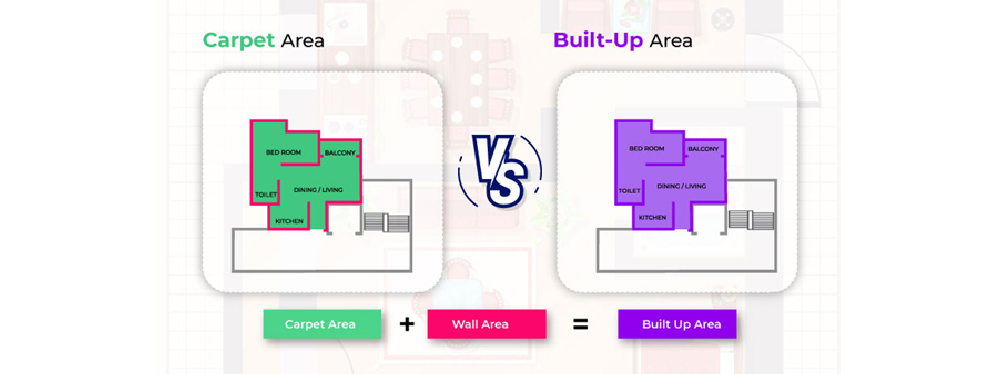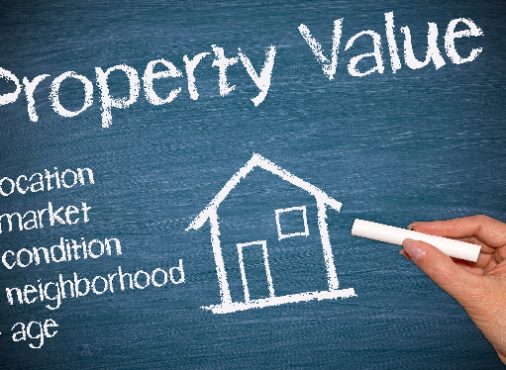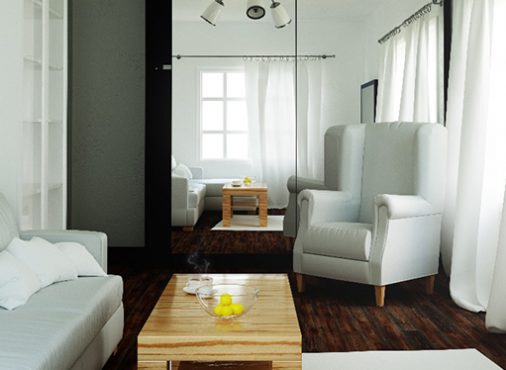When buying a property, especially in luxury real estate, carpet and built-up areas are key to decision-making. These are not just about the size of the property but also impact its usability, valuation and cost. Luxury buyers need clarity on these terms to know if the property is worth the price.
This blog post will explain carpet area and built-up area, the difference between them, and how to calculate one from the other. With this information, you can make smarter decisions for your real estate investments.
What is a Carpet Area?
The carpet area is the usable floor area inside the internal walls of the property, excluding the walls themselves or other semi-usable areas like balconies. It’s the part of the home that you live in.
What it Includes
- Bedrooms: The space where you unwind and recharge.
- Living Rooms: The heart of the home for socialising and relaxation.
- Kitchens: Functional spaces that allow you to prepare meals comfortably.
- Bathrooms: Personal spaces that are an essential part of the usable area.
What it Excludes
- Balconies and Verandas: While they provide aesthetic value, they are considered semi-usable spaces.
- Wall Thickness: Internal and external walls do not contribute to the carpet area.
- Common Areas: Shared spaces like lobbies or staircases in apartments.
Why It Matters for Luxury Homes
For luxury homebuyers, the carpet area directly determines the property’s practicality and comfort. A higher carpet area ratio ensures that most of the space you’re paying for is usable, translating into greater flexibility in designing your home. Larger carpet areas also enable spacious layouts, enhancing luxury properties’ aesthetic and functional appeal.
Read Also: The Future of Land Investment: Trends to Watch for in the Next Decade
What is a Built-Up Area?
The built-up area is the total area of the property, which includes the carpet area, the thickness of walls, and sometimes semi-usable spaces like balconies or utility areas. It represents the physical footprint of your home but often includes areas that you cannot actively use.
What it Includes
- Carpet Area: The usable living space.
- Wall Thickness: Both internal and external walls add to the built-up area but are not usable.
- Balconies and Utility Zones: Semi-usable areas that enhance the property’s features but don’t contribute to day-to-day living.
Why it Matters for Buyers
Developers often advertise properties using the built-up area, as this figure is larger and more visually appealing. However, buyers need to understand that the built-up area is not equivalent to the actual space they will use. For example, thicker walls in luxury homes may reduce the carpet area even if the built-up area remains impressive.
Why is Carpet Area Important?
In real estate, especially in the luxury segment, space is a premium commodity. Carpet area helps buyers understand how much of their property’s size is usable. This clarity is essential when assessing the value of a property and ensuring that it meets both functional and aesthetic expectations.
Key Reasons Why Carpet Area Matters
- Determines Usable Space: The carpet area defines the portion of the property you can use. Whether it’s for setting up furniture, hosting guests, or creating private spaces, the carpet area is what contributes to your day-to-day living experience.
For luxury buyers, larger carpet areas ensure more open, breathable, and comfortable spaces that complement upscale living.
- Value for Money: Luxury homes are priced at a premium, often calculated per square foot. By focusing on the carpet area, buyers can determine the real value for the money they are getting.
A property with a high carpet area-to-built-up area ratio ensures that more of the purchased space is usable, avoiding overpayment for structural elements or semi-usable areas.
- Impacts Layout and Comfort: The design and layout of a property are directly influenced by the carpet area. A spacious carpet area allows for thoughtful layouts with larger bedrooms, expansive living rooms, and better segregation of spaces.
In contrast, a low carpet area may lead to cramped interiors that fail to meet luxury standards.
Read Also: Top 5 Emerging Locations for Land Investment in India
How to Calculate Carpet Area from Built-Up Area
Calculating carpet area from built-up area involves understanding how much of the total property size is usable. This calculation can help buyers assess whether they are getting a good deal and avoid paying for unusable spaces.
Step 1: Understand the Ratio
Carpet area usually constitutes 70–80% of the built-up area. This ratio varies depending on the property’s design and construction. Luxury properties often have thicker walls or architectural features that may slightly reduce the carpet area ratio.
Step 2: Use the Formula
The standard formula to calculate carpet area is:
Carpet Area = Built-Up Area – (Wall Thickness + Other not usable Spaces)
Practical Example:
- Built-Up Area: 1,500 sq. ft.
- Wall Thickness: 200 sq. ft.
- Carpet Area: 1,500 – 200 = 1,300 sq. ft.
Factors That Influence Carpet Area in Luxury Properties
Carpet area ratios can vary significantly between properties, and luxury homes often come with unique design and construction considerations that influence these ratios. Buyers need to be aware of these factors to accurately evaluate a property’s usability and value.
Key Factors
- Architectural Design and Layout: Luxury properties are often designed with thick walls for enhanced structural integrity, soundproofing, or thermal insulation. While these features improve comfort and privacy, they may slightly reduce the carpet area. Additionally, unique layouts with curved walls or unconventional shapes can impact the usable space.
- Inclusion of Premium Features: Upscale homes may include premium elements such as double-height ceilings, larger windows, or expansive balconies. While these features enhance the property’s aesthetics, they may reduce the carpet area as more space is allocated to semi-usable or decorative elements.
- Local Building Codes and Regulations: In many locations, zoning laws and building codes influence the allocation of space. For instance, certain regulations may mandate larger setbacks or thicker external walls, which can reduce the carpet area relative to the built-up area.
Difference Between Carpet Area, Built-Up Area, and Super Built-Up Area
To fully understand your property’s size and usability, it’s important to differentiate between carpet area, built-up area, and super built-up area.
Key Differences
| Metric | Definition | Inclusions |
| Carpet Area | Usable floor area within walls. | Living rooms, bedrooms, kitchens, bathrooms. |
| Built-Up Area | Total property area, including walls and other not usable areas. | Carpet area + wall thickness + balconies. |
| Super Built-Up Area | Built-up area plus shared spaces. | Built-up area + proportionate share of common areas (lobbies, stairs, etc.). |
Conclusion
Understanding carpet areas and built-up areas is essential for making informed decisions, especially in the luxury real estate market. These measurements ensure you get the best value for your investment and a home that meets your spatial and lifestyle needs.
With a reputation for delivering thoughtfully designed homes, Rustomjee offers properties that prioritise usability, transparency, and luxury. Explore Rustomjee’s residential projects to experience premium living.
FAQs
- Why is the carpet area less than the built-up area?
The carpet area is always smaller than the built-up area because it excludes spaces like wall thickness, balconies, and utility zones. These areas, while part of the property, are not directly usable for daily activities. Understanding this distinction ensures buyers know exactly what they’re paying for.
- Does RERA mandate the disclosure of carpet areas?
Yes, as per RERA (Real Estate Regulatory Act), developers are required to disclose the carpet area in all agreements and advertisements. This ensures transparency and prevents buyers from being misled by inflated built-up or super built-up area figures. It’s a critical regulation for buyer protection.
- Does the ratio of carpet area to built-up area vary for residential and commercial properties?
Yes, the ratio of carpet area to built-up area often varies between residential and commercial properties. Residential properties usually offer a higher carpet area percentage (around 70-80%), while commercial properties may allocate more space for common areas and amenities, reducing the carpet area ratio. It’s advisable to review the property layout and builder specifications for clarity.








